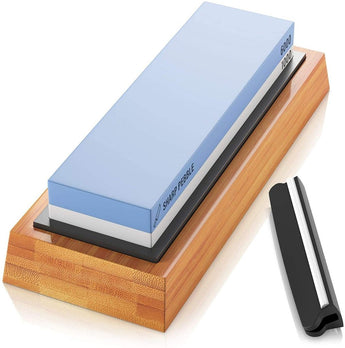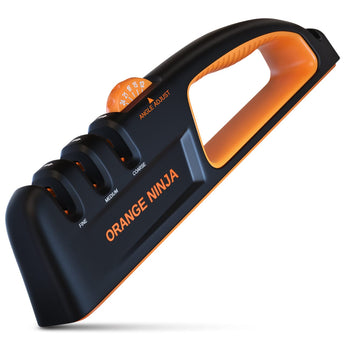
It is important to understand that giving your knife a razor-sharp edge is as much about the skill as it is about the tools you use. With a bit of patience and practice, you can teach yourself the sharpening skills that will save you both time and a good chunk of cash.
Within this article, we will discuss a few common mistakes (& how to correct them), that most people make when they get started with knife sharpening. Plus we’ll share some handy tips to know when your knife has been properly sharpened.
- Learning On A “Dead” Knife
We can see your eyebrow rising. Yes, you do need a dull blade to sharpen it but it’s not a wise choice to start learning on a knife that has gone completely dull. Because if you do; you will essentially be shooting in the dark.
It’s quite hard for a rookie sharpener to monitor the sharpening progress on a dull blade and secondly, it will take a lot more time to bring a completely dull blade back to life, which means you’re much more likely to give up halfway through. As a beginner, you should start honing your sharpening skills on a blade that’s in useable condition or even a new one. Put your sharpening skills to test once every couple of weeks.
- Constantly Changing Sharpening Technique
Patience is your most valuable ally when it comes to sharpening your blades. Often people tend to switch the angle if they don’t immediately see any progress. This basically puts you back to square one.
You must understand that if you’re working with a blade that’s quite dull or made out of hard steel then it will take at least half an hour to see any tangible progress. And if you happen to be a beginner, it’s best to seek professional help if the blade has gone completely dull.
- Not Choosing the Correct Stone Grit
It’s crucial that you understand the correct sharpening stone grits and how each of these impacts the blade. The key is to first correctly ascertain the level of work the blade needs. If it’s quite dull you will need to remove quite a bit of steel, which means you need to start with a coarse stone. If you start with a whetstone with too fine a grit, it will take you ages to produce a sharp edge.
Similarly, make sure your blade spends enough time on the current stone before moving onto to finer grit stones, otherwise, there will be inconsistencies in your blade’s edge.
- Using A Very Steep Sharpening Angle
It could be quite tricky to choose the correct angle if you’re just starting out. Here are two key factors that will dictate the angle you choose to sharpen your knife.
a) The degree of sharpness vs. edge robustness: The first factor that you have to consider is whether you want a super sharp hair splitting knife or an edge that lasts longer. Every time you sharpen a knife you will essentially be removing some metal from the edge. Sharpening at a lower angle means you’ll have a sharper knife but more metal removal and a higher angle mean less metal removal thus you end up with a thicker edge which means it’ll hold up longer.
b) Primary Use: Another factor that determines the sharpening angle is the usual use you put your knife through. For instance, if you use your knife primarily for carving, filleting, chopping or does it come in contact with hard objects more often
How To Tell The Knife Has Sharpened
- By Sight. One of the best ways to tell if the edge has properly sharpened is to see if any light is reflected off of it. Hold the knife under a bright light source and move it from side to side to see if any light reflects off of it. If the blade has been sharpened well you won’t notice any reflection. Make sure you pay good attention to the tip and heel of the blade because these are the 2 spots that mostly get neglected while sharpening.
- By Feeling The Edge. Usually, people just feel the burr and incorrectly conclude that the blade has been sharpened. The correct way is to first remove the burr by running the blade carefully over a piece of wood a few times. The removal of burr allows you feel precisely how sharp the blade is, thus removing any confusion.




Thank you so very much for creating such a supportive environment after the sale. I honestly rate you with an A+!!!